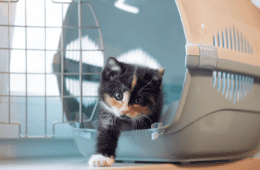This is what we asked them -
Share one mistake relating to the setup and maintenance of the litter box that you've seen owners commit and how to correct it.
16 experts rose to the challenge and provided some fascinating tips! They agree it's all about making the cat feel safe and comfortable. Listening to your cat and testing to see what he or she prefers is key.
Darlene Arden
You need one box per cat and one "for the house".
The most common problem I see when it comes to litter boxes is not having enough of them. The rule of thumb is one box for each cat and one for the house. If you only have one cat you are probably thinking that you don’t need a second litter box. Yes, you do.
If you have more than one cat, start increasing the number of boxes. Do not line the boxes up like urinals. If your home is on more than one level, put the boxes on different levels. Remember to keep all boxes scrupulously clean. Your cat(s) will not want to use a dirty bathroom any more than you would.
Darlene Arden is a certified animal behavior consultant, a lecturer and an award-winning writer of hundreds of articles and columns for all of the major dog and cat publications. She is also the author of the books The Complete Cat's Meow and Beautiful Cats.
Sally E. Bahner
The location of the litter box needs to be convenient for the cat, not you.
Owners place the box in a location that’s convenient to them, rather than the cat. That may be in the garage or the basement where it’s easy to forget about it in terms of keeping it clean and in monitoring the cat’s habits.
If the box is in a “hidden” location, you can’t tell if the cat may be straining when urinating or defecating. Likewise, a covered litter box is also easy to overlook in terms of scooping and may trap odors, discouraging use by the cat.
Sally Bahner has spent the last 15 years specializing in feline-related issues, specifically nutrition, holistic care and multiple cat behaviors. She has offered her services as a feline behavior and care consultant and speaker. Visit Sally's blog ExclusivelyCats where she shares resources for cat care and nutrition, product reviews and personal stories.
Deborah Barnes
Don't make any changes unless you have to.
As a cat blogger, I'm often approached by cat litter manufacturers for product reviews. While flattering, the number one rule in my multi-cat household is "If it's not broken, don't fix it," especially when it comes to the litter box, and so I always politely decline.
Years ago, I was the type of person that would buy whatever kind of litter was on sale and didn't realize it could be stressing my cats. Cats are territorial by nature - they are also fastidious and creatures of habit. If the type of litter they are accustomed to suddenly changes, it can disrupt their equilibrium, and they communicate their displeasure by peeing or pooping outside the box. Once I understood the root cause of the problem and found a brand of litter my whole gang liked, I've kept loyal to it and the litter issues vanished.
Deborah Barnes is the V.P. of the Cat Writers' Association. She is an award-winning blogger, author, and cat advocate whose greatest mission is to create public awareness through educational efforts about the need for spay/neuter. Her award-winning blog Zee & Zoey's Cat Chronicles covers the everyday journey of the author and her family of seven cats, along with topics ranging from the humorous behaviors of cats to very serious subjects on pet responsibility.
Leslie Goodwin
The litter box has to be large enough for your cat to use in comfort.
Some cats pee standing up! Is your box high enough and big enough?
I knew that some senior cats with bad joints might have trouble squatting to pee but I was shocked to see my young cat back up to the edge and pee over the side! I wonder if this is the reason she was abandoned four times before. She is tall and rangy and requires a tall, roomy expanse to hit the target.
The perfect fit was a covered box with a clear lid so she has a view and feels safe. And I cut an entry notch into a plastic storage bin for her second box because most commercial boxes are just too small to contain her huge personality, and an open box is easier to clean.
Leslie Goodwin worships cats and glorifies all the mere mortals who serve them. She is the author of award-winning CAT SKILLS: Loving Care for Cats available on Amazon.com or from the author, Leslie Goodwin, writer on Facebook.
JaneA Kelley
Most cats prefer a soft sandy litter. Find the litter your cats prefer, not the one that you do.
Be careful about litter texture. Cats generally prefer a soft, sandy litter to pellets, marbles or pebbles. Given that cats evolved from desert creatures, it’s not hard to believe that they might instinctively prefer a sandy substrate. Cats that are declawed, in particular, have trouble with hard litter because it hurts their feet and can cause litter box avoidance. For declawed cats I recommend soft litters such as corn-based, clumping clay or wood shavings simply because those products will be easier on their paws.
I made the litter texture mistake with my own cats. At one point I bought a pellet-style cat litter made from pine. It smelled great, but one of my cats absolutely would not tolerate the texture, so she chose to urinate and defecate in my shower instead. As soon as I changed back to a standard clumping litter, she started using the box again.
JaneA Kelley is a lifelong cat lover who has been writing her award-winning cat blog, Paws and Effect, since 2003. Each week, the Paws and Effect Gang answers a letter from a reader with advice about health or behavior issues. She gratefully and gracefully accepts her status as chief cat slave for her family of feline bloggers.
Libbie Kerr
Don't place the box too far away. In multi-storeyed homes, place one box on every level.
Jan and Bill were thrilled with their second kitten, but the new kitten was using the bathroom throw rug in the morning and not the litter box. A few questions and answers identified the problem. They had three litter boxes, all the right type, and the right litter, and all three were in the basement utility room of a two-storey home. While the older cat navigated the adventure of finding the litter box, the new kitten had difficulty negotiating the three levels. By simply placing a litter box on every level, easily accessible and known to the kitten, the problem was solved. No more issues with the litter box. Litter box placement is important to consider at all times; I find it is one of the most important aspects of training and supporting a cat’s natural instinct to use them.
Libbie Kerr has been a breeder of Bengal cats since 1989. She also writes and lectures on temperament inheritance, the importance of ownership understanding, top showing and other cat-related topics. You can read more about Libbie and her cats on her website A-Kerr's Bengals
Ramona Marek
Some cats need a large litter box with sides over 12 inches high.
A litterbox tip for improved setup is to choose a large, roomy litter box that has sides over 12 inches high. Not all mishaps are behavioral or medical, but a matter of personal “style.” Some mishaps happen while kitty is appropriately using the litter box. Some cats pee standing up, and some older or arthritic kitties have difficulty aiming so the urine misses the box and pools on the floor. Several companies make larger litter boxes with higher walls in assorted colors, and even a corner shape is available. Alternatively, you could use a large plastic storage box and cut out an entrance.
Natasha is an overachiever with a personal motto of “aim high”, and her personal style is to raise her backside as she pees. Urine missed the box, hit the wall and pooled under the litter mat. Messy! Using a litter box with high sides has eliminated that problem and keeps urine inside the litter box. Happy kitty, happy owner!
Ramona D. Marek, MS Ed, is an award-winning writer and author. She is a one of a handful of non-veterinarian members of the American Association of Human-Animal Bond Veterinarians and a former member of the International Association of Animal Behavior Consultants (IAABC). Ramona is also the Author of Cats for the GENIUS. You can read more about Ramona and her work at www.RamonaMarek.com.
Maryjean Ballner
Pay attention as your cat's needs may change as she/he ages.
When my 16 year old tabby started feeling his age, he didn’t squat as deeply when he urinated in the litter box. I noticed that some of the spray flew over the sides of the litter box.
Instead of searching out the traditional deep litter boxes found at pet stores, I went to Bed, Bath & Beyond and bought a large plastic tub. The new litter box measures 22 “ x 17 “ x 8” and it’s solved the problem. It cost about $8.99, well less than the cost of a traditional litter box. This may not work if your cat can’t climb in and out easily.
Both of my cats are happy with this new arrangement, and there’s no unintentional, unwanted mist now - we’re all happy.
Maryjean Ballner wrote the books and DVDs on “Cat Massage” and “Dog Massage.” Her expertise is working with scared and traumatized cats and she offers workshops in Japan and throughout the United States.
BJ Bangs
Long-haired cats may seem to have litterbox issues when in fact the problem is with their long hair.
Some litterbox issues are unique for long-haired cats. Little Yellow is an 8-year-old long-haired orange Tabby who has asthma. Once in awhile we find a solid piece of poop on the floor. It might seem like Little Yellow is avoiding the litter box, but the truth is poop gets stuck in his fur and then drops off to the floor.
Because of his health challenges, he cannot be periodically put under anesthesia to be shaved. Instead, every 2 to 3 months we schedule a butt-trim. We go to the vet, and there they take out the razor and trim off inches of hair from his hind legs and the lower part of his tail. It’s like magic. For months, there’s no more issues.
BJ Bangs is an award-winning journalist, photographer, and communications professional. She is the recipient of the Cat Writers' Association’s Muse Medallion and Certificate of Excellence. She blogs about everything cat, their humans, and their connection at bjbangs.net.
Susan Bulanda
Cats can outgrow the box they used as kittens and may need a larger and uncovered box to accommodate their full size.
A client called me with a litterbox problem. The cat had used the litter box while he was a kitten, but when he reached about a year old he stopped using the box. The cat seemed to like the litter and the location of the box, which was in an isolated, quiet spot that was readily accessible to the cat.
What could the problem be? When looking at the cat and comparing the size of the cat (very large) to the covered litter box, it became obvious that the box was too small for the cat.
We decided to find a litter box that was larger with higher sides. Then I had them take a cardboard box and cut pieces to go around three sides of the litter box and tie the cardboard to the outside of the box to give it a little more height. Within a day the cat was using the litter box again with no problem. He did not seem to mind the higher sides, and the cardboard kept the litter in the box.
Susan Bulanda started her career as a dog trainer while still in high school. She is recognized worldwide as a canine and feline behavior consultant, expert in canine Search and Rescue and as an award-winning author and Adjunct Professor. You can read more of Susan's writing on her website and in her blog.
Barbara Florio Graham
Listen to what the cat is telling you and get him/her to the veterinarian.
Penny was faithful about using the litter box for months, but suddenly began to defecate right beside the box, on the plastic mat.
It happened to be close to her annual vet checkup, and he and I agreed she might be trying to tell me she was occasionally constipated or bothered by hairballs. He suggested changing the treats I was giving to hairball treats, and to also add Laxatone every few days. In addition, I decided to give her a second box beside the first one, and this has worked beautifully.
I think this reinforces my decision to always “ask the cat” if there's a problem. The worst thing one can do is to punish. I did scold Penny when I caught her outside the box, and picked her up and put her inside. But the next time, she called me before she did it, so she was clearly trying to tell me something! How considerate of her to select the plastic mat just outside the box, instead of some other spot.
Barbara Florio Graham has written extensively about cats, although she is primarily a book consultant and marketing expert. Her website is named after the cat who made her famous when he was published widely and was a favorite on CBC radio. Read the blog and check links from there at: http://SimonTeakettle.com/blogsimont.htm
Dr. Jean Hofve, DVM
Many cats refuse to use a covered litter box and prefer an open one.
A client needed advice about her elderly kitty, Misty, who had started urinating on the living room rug. We thoroughly cleaned and deodorized the rug and box with an effective product, but the behavior continued sporadically.
We knew that Misty had moderate chronic kidney disease, but she was getting subcutaneous fluids and was still eating well with no other changes in behavior, so that seemed unlikely to be the problem, or at least not the only problem.
However, Misty’s litter box, which she had reliably used her whole life, was the kind with a hood. I suggested removing the hood—which turned out to be an instantaneous and miraculous cure! But a few weeks later, the client suddenly decided that it would be a great idea to start using litterbox liners, and the house soiling resumed. So we can learn two lessons from this: (1) a less-confining box is a good thing, and (2) if it ain’t broke, don’t fix it!
Jean Hofve, DVM, is a retired holistic veterinarian with more than 20 years of experience in integrative veterinary medicine. She is also the award-winning co-author of The Complete Guide to Holistic Cat Care: An Illustrated Handbook with nutritionist Dr. Celeste Yarnall. Visit Dr. Jean's website LittleBigCat.com to read more of her work.
Marci Kladnik
If your cat avoids the box, experiment to find his/her preferences in litter and boxes.
My suggestion is to definitely listen to what your cats are trying to tell you when they start missing the box. Ruling out medical reasons first, it might be the litter, the box, the box location, or a combination. Offer several different kinds of litter including different textures. The boxes that are used are cat approved, so accept the decision and go with it. You may need to always have two different kinds of litter if you have multiple cats.
In the past few months one of my four, Barney, started peeing and pooping on the grass in the catio. Thinking it might be the litter, I set up three new litter boxes with different litters in them. Pees (pun intended) was once again restored.
Marci Kladnik is the president of the Cat Writers’ Association. She has written about and dealt with feral cats and kittens for nearly a decade. In-home fostering has taught her much about soothing frightened and timid cats in order to socialize them for adoption. You can read more award-winning articles by Marci on the Catalyst For Cats website where she volunteers to further promote the understanding of feral cats.
Dr. Marci Koski
Place the box where the cat can see her surroundings and feel safe.
In nature, cats are not only predators, but they can also be prey. Because urinating and defecating are activities that make cats vulnerable to attack from potential predators, they have evolved to choose places for elimination that make them less vulnerable to sneak-attacks.
You’ll need to place your cat’s litter box where she feels confident that no one is going to interrupt her activities. Even if you only have one cat, the potential for predators hiding in wait could simply be a “perceived” threat that may make your cat avoid a particular litterbox location.
I had a client who had a BEAUTIFUL room dedicated to her cat’s litter boxes. However, a couple of her cats started avoiding the (uncovered, clean, and open) litter boxes, which were all lined up against the wall, and opted for urinating in the middle of the room. The problem? Cat shelves and perches were placed on the walls, some directly above the litter boxes. These perches created blind spots for the cats when they were in the litter boxes, as the cats could not tell if there was someone waiting for them to pounce from above.
Dr. Marci Koski is a certified feline behavior and training professional. Marci works with cats and their people to resolve behavior issues and educate guardians about the needs of their cats. The mission of her business, Feline Behavior Solutions, is to keep cats in homes and out of shelters.
Pam Johnson-Bennett
In a multi-cat household, make sure the cat's route to the litter box isn't blocked by a rival.
When it comes to the litter box, one mistake that cat parents make that’s easily missed is territorial consideration. You may have an adequate number of boxes for your multicat household, but placement might be what creates stress for the cats. In a multicat home, cats may already have to tolerate overlapping personal territories. If there’s any tension among them, it can cause reluctance to cross through another cat’s preferred area to reach the litter box. For a lower-ranking cat or one who is fearful, it may be less stressful to simply eliminate on the carpet in his own area rather than risk a confrontation or ambush.
I just recently visited a client’s home where she had five litter boxes for her three cats but was unaware that one of the cats was positioning himself in the middle of the hallway to guard access to the room where all the boxes were located. The cat parent misinterpreted his behavior as simply lounging when, in fact, he was sending a clear message to the other cats. Scattering the boxes throughout the house to cover each cat’s preferred area solved the problem.
Pam Johnson-Bennett is the best-selling author of 10 books and was the host of Animal Planet’s Psycho Kitty. Her latest book, CatWise (Penguin Books 2016), was just released this month. She is also the author of (Penguin Books) and Cat vs. Cat (Penguin Books), two books referred to as cat bibles by veterinarians, behavior experts and cat parents worldwide. With a career that spans more than three decades, Pam is considered a pioneer in the field of cat behavior consulting. Her website is www.catbehaviorassociates.com.
Amy Shojai
Provide several boxes and place them in different locations.
I often recommend the 1+1 rule for cats and litter boxes: 1 box per cat, plus one. That's because often kitties don't want to share facilities and "go" after another cat, or they prefer one box for solids and another for liquids.
While many cat parents understand this and do provide multiple boxes, they may let convenience rule and situate all the boxes in a single location. That can cause problems when one cat lays claim to a particular box or room of the house. When that happens, the other cats must trespass on the other cat's property to reach the facilities--and instead of risking a face off, they simply "go" somewhere else.
Cats may keep other cats away from certain areas simply by staring at the doorway. So providing multiple boxes in different rooms (opposite sides of the house or different floors) means King Cat can't guard all at once. That allows the other cats to eliminate in peace.
Amy Shojai is a nationally known pet behavior expert, certified behavior consultant and author of more than 30 award- winning pet care books. You can read more about Amy and her work at Shojai.com. Check out her blog Bling, Bitches & Blood too for practical solutions for pets' problems & publishing advice.
On behalf of the TheCatSite.com's community, I'd like to thank the experts for taking part in this round-up and sharing such excellent litterbox care tips with us! Let us know what you think about them in the comments below and share your own tips too!
Please don't post questions about your cats in the comments section. Instead, post them in our cat behavior forums where other members are more likely to see them and respond.
Is your own cat avoiding the box? Start by reading our concise step-by-step guide to dealing with litterbox problems:
Do you know of someone else who might benefit from the information in this post? Please share it with them through Facebook, Twitter or in an email. Here are direct links to our Facebook post and to the Pinterest pin - likes and shares are always appreciated!
Note: We may get commissions for purchases made through links on this page.





















9 comments on “16 Experts Reveal The Most Common Litterbox Mistakes (and How To Avoid Them)”